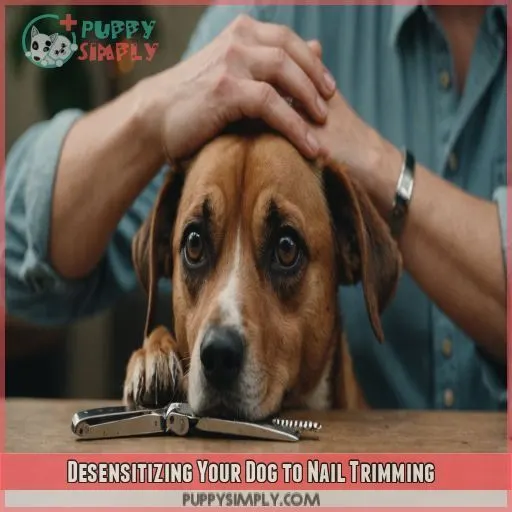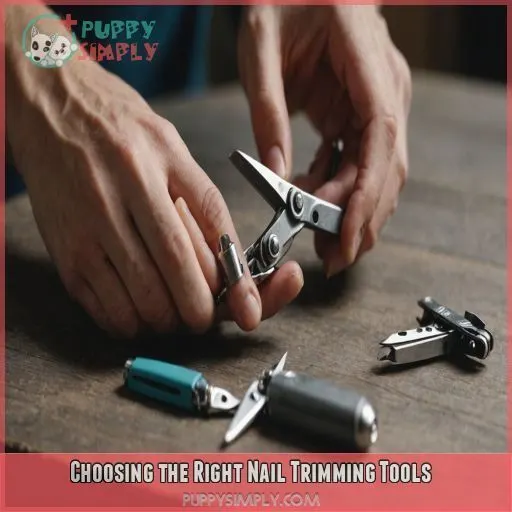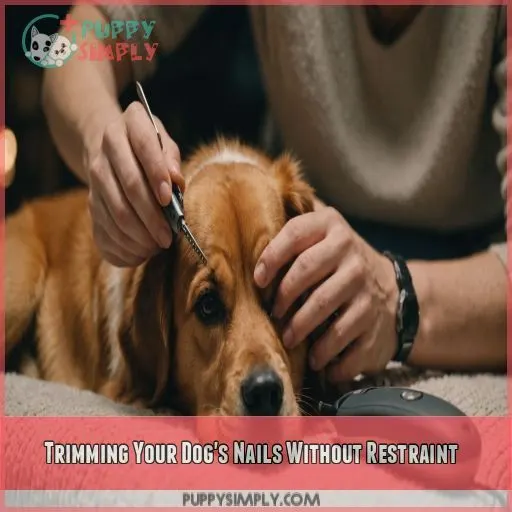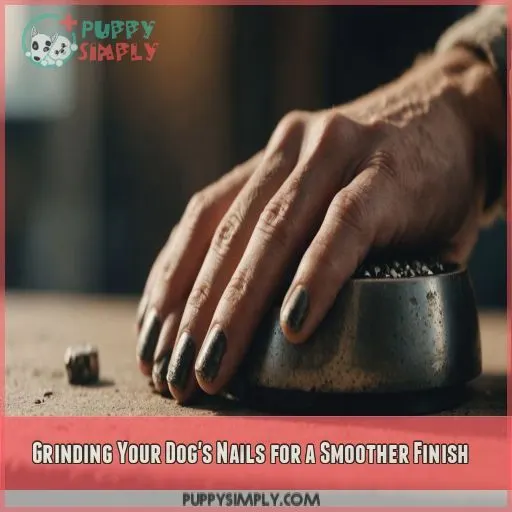This site is supported by our readers. We may earn a commission, at no cost to you, if you purchase through links.
 Trimming your dog’s nails without restraint is a goal many of us strive for, but few achieve.
Trimming your dog’s nails without restraint is a goal many of us strive for, but few achieve.
With the right approach, you can master this skill and keep your furry friend calm and safe.
Start by desensitizing your dog to nail trimming through positive reinforcement techniques, like treats and praise.
Gradually introduce the nail clippers, and before you know it, your dog will be tolerating nail trims like a pro.
You’ll be in control, and your dog will thank you for it.
But that’s just the beginning – there’s more to explore to make sure a stress-free nail trimming experience.
Table Of Contents
- Key Takeaways
- Desensitizing Your Dog to Nail Trimming
- Choosing the Right Nail Trimming Tools
- Trimming Your Dog’s Nails Without Restraint
- Grinding Your Dog’s Nails for a Smoother Finish
- Maintaining Your Dog’s Nail Health
- Frequently Asked Questions (FAQs)
- How to trim dog nails when they won’t let you?
- What can I use instead of dog nail clippers?
- How do you trick your dog into letting you cut their nails?
- How do I restrain my dog from nail clipping?
- How often should I trim my dogs nails?
- Can I trim my dogs nails at home safely?
- What are the benefits of grinding my dogs nails?
- How can I stop my dogs nail from bleeding?
- Are there any risks associated with not trimming my dogs nails?
- Conclusion
Key Takeaways
- You can master dog nail trimming without restraint – and it’s a total game-changer! With patience, practice, and positive reinforcement, you’ll be a pro in no time, and your furry friend will thank you for it.
- Desensitizing your dog to nail trimming is key. Start by gently handling their paws, introducing fake clippers, and rewarding calm behavior. Gradually build up to real clippers and nail trimming – it’s a journey, not a destination!
- Grinding your dog’s nails is a great alternative to clipping, especially if they’re nervous or have black nails. It reduces the risk of cutting the quick, is often less stressful, and leaves nails with a healthy shine – what’s not to love?
- Safety first: invest in sharp clippers, styptic powder, and a nail grinder with safety features. Trim at the right angle, avoid cutting the quick, and take breaks to give your dog a chance to relax – their comfort is key to stress-free nail trimming.
Desensitizing Your Dog to Nail Trimming
You’re probably dreading the drama that comes with nail trimming, but don’t worry, desensitizing your dog to this process can make all the difference. By starting early and using positive reinforcement techniques, you can help your furry friend feel more comfortable and relaxed during nail trimming sessions, making it a breeze for both of you (Source).
Starting Early With Puppies
Your puppy’s early experiences shape their nail-trimming tolerance. Start by gently handling their paws, making it a pleasant experience with treats and praise. Introduce the nail clipper gradually, beginning with visual exposure, then touch, and eventually, clipping. Establish a regular nail-trim schedule to maintain calmness.
Here are 4 tips to get you started:
- Handle your puppy’s paws daily for desensitization
- Introduce the nail clipper in short sessions
- Reward calm behavior with treats and praise
- Schedule nail trims every 4-6 weeks for consistency
Using Positive Reinforcement Techniques
As you start early with your puppy, you’ll want to incorporate positive reinforcement techniques to make nail trimming a breeze. Reward your furry friend with treats and praise for remaining calm, building their confidence (and yours!). With patience and consistency, operant conditioning will kick in, making dog nail trimming a stress-free experience for both of you.
Gradually Introducing Nail Clippers
Now that you’ve got your puppy comfortable with having their paws handled, it’s time to bring out the big guns – or rather, the nail clippers. Start by simply showing them to your puppy, then gradually introduce the sound and sensation of the clippers while rewarding calm behavior. This gradual exposure will help your puppy become desensitized to the clippers.
Simulating Nail Trimming With Fake Tools
To help your dog get comfortable with nail trimming, try simulating the experience with fake tools. Use a pencil or a similar object to mimic the sensation of clippers. Reward your dog’s calm behavior with treats and praise. Gradually increase exposure to the fake clippers, making it a positive experience. This will make the actual nail trimming process much smoother.
Counter-Conditioning for Stress-Free Trimming
Now that you’ve simulated nail trimming with fake tools, it’s time to counter-condition your dog for stress-free trimming.
Start by associating nail trimming with positive experiences, like treats and praise.
Gradually increase exposure to the nail clipper, while reducing your anxiety.
With patience and consistency, you’ll desensitize your dog to nail trimming in no time.
Choosing the Right Nail Trimming Tools
Getting ready to trim your dog’s nails?
You need the right tools to make the experience stress-free and safe for both you and your furry friend.
With the numerous types of nail clippers and grinders available, selecting the best one for your dog’s nail type and your comfort level will make all the difference in a successful nail trimming session.
Types of Nail Clippers and Grinders
Choosing the right nail clippers and grinders can be overwhelming.
You’ve got clipper types like scissor-style, guillotine, and nail scissors, each with pros and cons.
Grinders offer a smoother finish, with features like variable speed and nail guides.
Top brands like Oster, Andis, and Dremel offer reliable options.
Consider safety concerns, like noise level and heat generation, when making your choice.
Selecting the Best Tool for Your Dog’s Nail Type
How do you choose the perfect tool for your dog’s unique nail type? First, consider the size and shape of their nails. Clippers are ideal for thicker nails, while grinders suit smaller, more delicate ones. Look for tools with adjustable sizes or interchangeable blades to accommodate your dog’s specific needs. Research reputable brands for the best fit.
Safety Precautions for Nail Trimming
For safety precautions when trimming your dog’s nails, you want to be prepared, not panicked. Invest in sharp clippers and a nail grinder with safety features to prevent accidents. Trim at a proper angle, taking care not to cut the quick. Prioritize your dog’s comfort and have a plan in place in case of bleeding.
Using Styptic Powder to Stop Bleeding
Don’t panic if your dog’s nail starts bleeding after trimming.
It happens!
Styptic powder is your savior.
Apply a small amount to the nail using a cotton swab, and the bleeding should stop within seconds.
Alternatives like cornstarch or baking soda can also work, but styptic powder is the most effective.
Keep it on hand for quick bleeding control.
Trimming Your Dog’s Nails Without Restraint
You’re about to master the art of trimming your dog’s nails without restraint, making the experience a breeze for both you and your furry friend. By learning a few simple handling techniques and restraint methods, you’ll be able to keep your dog calm and safe while keeping those nails perfectly trimmed.
Handling and Restraint Techniques
The art of handling and restraint techniques! To trim your dog’s nails without restraint, focus on creating a safe and calm environment. Here are three tips to get you started:
- Drape your arms and upper body over your dog to prevent movement.
- Keep your left forearm over your dog’s neck when trimming front claws.
- Lean your upper body over your dog’s shoulders to prevent rising.
Trimming Nails at the Right Angle
Trimming nails at the right angle is really important for a safe and stress-free experience. Hold the clipper so that it’s parallel to the nail and snip straight across, being mindful of the curve. For dew claws, use scissors-type clippers and trim at a 45-degree angle. This technique helps maintain the ideal nail length and prevents uneven growth.
Avoiding the Quick and Preventing Pain
Now that you’re trimming at the right angle, it’s time to master the art of avoiding the quick.
The quick is the sensitive part of the nail that can be painful if cut.
Watch for signs like nail bleeding, yelping, or pulling away.
If you do cut the quick, apply styptic powder to stop the bleeding.
Give your dog a break to avoid associating nail trimming with pain.
Tips for Trimming Dew Claws and Black Nails
For trimming dew claws and black nails, you’ll want to exercise extra caution. For dew claws, use a scissors-type clipper and trim just the tip, being mindful of the quick. For black nails, use a nail grinder or clipper with a safety stop to avoid cutting too short. Remember, patience and gentle paw handling are key.
Grinding Your Dog’s Nails for a Smoother Finish
You’re about to take your dog’s nail care to the next level by learning the art of grinding their nails for a smoother finish. Grinding is a fantastic alternative to clipping, as it can be less intimidating for your dog and provides a more natural, rounded shape to their nails, reducing the risk of scratches and snagging.
Benefits of Nail Grinding Over Clipping
Now that you’ve mastered trimming your dog’s nails without restraint, let’s talk about grinding – the secret to a smoother finish! Grinding offers three key benefits:
- Less stress: No loud clipping sounds or risk of cutting the quick.
- Quick protection: Reduces the risk of bleeding and pain.
- Nail shape control: Allows for a more precise, rounded nail shape.
Choosing the Right Nail Grinder for Your Dog
Now that you know the benefits of nail grinding, it’s time to pick the perfect tool for your furry friend. When choosing a nail grinder, consider the type (electric or manual), your dog’s nail structure, and the noise level. Look for safety features like a secure grip and adjustable speed to make sure you have a smooth, stress-free grinding experience.
Techniques for Grinding Your Dog’s Nails
Now that you’ve chosen the right nail grinder for your dog, it’s time to learn the techniques for grinding their nails. Grinding can be a bit tricky, but with practice, you’ll get the hang of it. Here are some tips to get you started:
- Start with short sessions to avoid overwhelming your dog
- Use a gentle touch and gradually increase the grinding frequency
- Be mindful of nail sensitivity and adjust the grinder attachment accordingly
- Choose the right grinder size for your dog’s nail type
- Reward your dog with treats and praise for their good behavior
Safety Precautions for Nail Grinding
Now that you’re grinding like a pro, let’s talk safety. When using a nail grinder, control the speed and pressure to avoid heat buildup, which can be uncomfortable for your dog. Keep the grinder moving to prevent overheating, and take breaks to give your dog a chance to relax. Your dog’s comfort is key to stress-free nail trimming.
Maintaining Your Dog’s Nail Health
You’ve made it to the final stretch – maintaining your dog’s nail health is a long-term commitment.
But with the right techniques and mindset, it can become a breeze.
By staying on top of regular nail trimming, monitoring your dog’s nail growth, and adjusting your technique as needed, you’ll be able to keep those claws in tip-top shape.
This will also help prevent potential health issues down the line.
Importance of Regular Nail Trimming
Regular nail trimming is really important for your dog’s overall health and comfort. Long nails can cause pain, lead to joint issues, and even affect traction. By trimming your dog’s nails regularly, you’ll prevent nail infections and promote healthy foot comfort. Aim to trim every 4-6 weeks, or as needed, to keep your dog happy and healthy.
Monitoring Your Dog’s Nail Growth
Keep an eye on your dog’s nail growth rate and length to determine the best trimming schedule.
You should check for changes in nail color, texture, and quick location.
For dogs with long nails, trimming every 4-6 weeks may be necessary, while those with short nails might need trimming every 6-8 weeks.
Monitor and adjust to keep your dog’s nails healthy and pain-free.
Adjusting Your Trimming Technique as Needed
As you monitor your dog’s nail growth, you’ll notice patterns unique to their breed and individual needs. Be prepared to adjust your trimming technique accordingly. Some dogs may require more frequent trims due to quick growth, while others may need less pressure to avoid quick sensitivity. Consistency is key to achieving a healthy nail shape and promoting quick recession.
Frequently Asked Questions (FAQs)
How to trim dog nails when they won’t let you?
Don’t worry, you’re not alone! Trimming your dog’s nails can be a tough task, but with patience, positive reinforcement, and the right techniques, you can master it. Start by gradually desensitizing your dog to the nail clippers (Source).
What can I use instead of dog nail clippers?
Don’t stress if clippers aren’t your thing! You can use a dog nail grinder or Dremel tool instead. These alternatives are perfect for smoothing out your pup’s nails, making the process easier and less intimidating for both of you.
How do you trick your dog into letting you cut their nails?
You don’t need to trick your dog, just gently desensitize them to nail trimming by massaging their paws, introducing fake clippers, and rewarding calm behavior. Gradually build up to real clippers and nail trimming.
How do I restrain my dog from nail clipping?
Are you ready for a wrestling match? Restrain your dog by gently draping your arms and upper body over them, placing your forearm over their neck, and gripping each toe firmly with your thumb and forefinger.
How often should I trim my dogs nails?
Trim your dog’s nails every 4-6 weeks, or as needed, to prevent overgrowth. Keep an eye on their nail length and adjust the trimming schedule accordingly. Regular trims will help your dog stay comfortable and healthy.
Can I trim my dogs nails at home safely?
Trimming your dog’s nails at home can be a tough task, but with the right tools and techniques, you can master it! Start by getting your dog comfortable with nail handling, then gradually introduce clippers and practice caution.
What are the benefits of grinding my dogs nails?
Grinding your dog’s nails is a great alternative to clipping! You’ll reduce the risk of cutting the quick, and it’s often less stressful for your furry friend. Plus, it helps smooth out ridges and leaves nails with a healthy shine.
How can I stop my dogs nail from bleeding?
Did you know that 1 in 5 dogs experience nail bleeding during trimming? Don’t panic! If your dog’s nail starts bleeding, apply styptic powder or a clotting powder to the nail to stop the bleeding quickly and effectively.
Are there any risks associated with not trimming my dogs nails?
You’re probably wondering, "What’s the big deal if I don’t trim my dog’s nails?" Well, neglecting nail trimming can lead to pain, deformed feet, and injured tendons, so it’s really important to stay on top of it!
Conclusion
Mastering the art of dog nail trimming without restraint can be a game-changer for both you and your furry friend.
It can transform a stressful experience into a stress-free one.
By following the right techniques, you can become a pro at trimming your dog’s nails in no time.
With patience, practice, and positive reinforcement, dog nail trimming without restraint is achievable.











